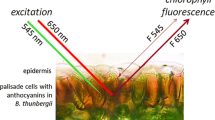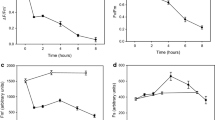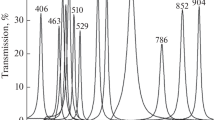Summary
The epoxidation of zeaxanthin to the di-epoxide violaxanthin via the mono-epoxide antheraxanthin (called the backward-reaction), is examined with several plant objects and under various conditions.
In Chlorella and in the needles of Taxus baccata a backward-conversion can be observed immediately after the termination of strong illumination. The reaction can be accelerated somewhat by exposure of the plant material to pure O2 or dim light.
One cannot observe such an epoxidation in leaf disks of Spinacia oleracea under normal conditions (dark, air). It begins only under the influence of dim light or when pure oxygen is supplied. The absence of the backward-reaction under the given experimental conditions is a consequence of a closure of the stomata, which begins during the strong illumination and continues in the succeeding dark period; it is therefore a consequence of anaerobiosis in the plastid-containing cells. Yet a backward-reaction starts if the O2-tension in the cells is increased either by pure O2 given from outside or by the intracellular evolution of photosynthetic O2 (associated with a partial opening of the stomata).
The concentration of the intermediate antheraxanthin increases strongly more at the beginning of the O2- or dim-light-promoted backward-reaction than the concentration of the endproduct violaxanthin. Hence it follows that during epoxidation the two O-atoms are added to the 5,6- and the 5′,6′-position of the zeaxanthin not simultaneously but one after the other.
In isolated chloroplasts or cell fragments no backward-reaction could be observed under various conditions tested. An apparent backward-reaction in lyophilized cells or chloroplasts, which is triggered by light or O2-atmosphere, is a result of the different velocity of the photooxidative destruction of carotenoids.
The in vivo epoxidation of zeaxanthin, which probably is catalysed by a Cu-containing enzyme, only proceeds in the presence of molecular O2.
Zusammenfassung
Die als „Rückreaktion” bezeichnete Epoxidierung des Zea. 2über das Monoepoxid Anth. zum Diepoxid Viol. wird an verschiedenen pflanzlichen Objekten und unter verschiedenen Bedingungen untersucht.
In Chlorella und den Nadeln von Taxus baccata ist sofort nach Beendigung der starken Belichtung die Rückumwandlung zu beobachten. Diese ist durch Begasung des Pflanzenmaterials mit reinem O2 oder durch schwaches Licht noch etwas zu beschleunigen.
In Blattscheibchen von Spinacia oleracea ist eine solche Epoxidierung unter Normalbedingungen (Dunkelheit, Luft) nicht festzustellen. Sie setzt erst unter dem Einfluß von schwachem Licht oder bei Zufuhr von O2 (100%) ein. Das Fehlen der Rückreaktion hat seine Ursache in einem unter den gegebenen Versuchsbedingungen stattfindenden Spaltöffnungsverschluß, der während der Starklichtgabe beginnt und während der nachfolgenden Dunkelheit noch anhält, und einer daraus resultierenden Anaerobiose in den plastidenhaltigen Zellen. Durch eine Erhöhung der O2-Spannung in diesen Zellen, entweder durch von außen zugeführten reinen O2 oder durch intracelluläre Entwicklung von Photosynthese-O2 (verbunden mit einer teilweisen Öffnung der Stomata), kommt es auch in den Spinatblättern zu einer Rückreaktion. Schwaches Licht kann also auf indirektem Weg die Rückreaktion beschleunigen.
Die Konzentration des Zwischenproduktes Anth. nimmt bei der O2-oder schwachlichtgeförderten Rückreaktion anfänglich stärker zu als das Endprodukt Viol. Daraus folgt, daß bei der Epoxidierung die beiden O-Atome nicht gleichzeitig, sondern nacheinander in die 5,6- und 5′,6′-Stellung des Zea. eingebaut werden.
In isolierten Chloroplasten oder Zellfragmenten konnte bisher unter verschiedensten Bedingungen keine Rückreaktion nachgewiesen werden. Eine in gefriergetrockneten Zellen oder Chloroplasten durch Licht und O2-Atmosphäre ausgelöste scheinbare Rückreaktion ist auf eine verschieden schnelle photooxidative Zerstörung der Carotinoide zurückzuführen.
Die Epoxidierung des Zea., welche durch ein wahrscheinlich Cuhaltiges Enzym katalysiert wird, ist in vivo an das Vorhandensein von molekularem O2 gebunden.
Similar content being viewed by others
Literatur
Hager, A.: Die Zusammenhänge zwischen lichtinduzierten Xanthophyll-Umwandlungen und Hill-Reaktion. Ber. dtsch. bot. Ges. 79, (94)-(107) (1966).
—: Untersuchungen über die lichtinduzierten reversiblen Xanthophyllumwandlungen an Chlorella und Spinacia. Planta (Berl.) 74, 148–172 (1967).
—, u. T. Meyer-Bertenrath: Die Isolierung und quantitative Bestimmung der Carotinoide und Chlorophylle von Blättern, Algen und isolierten Chloroplasten mit Hilfe dünnschichtchromatographischer Methoden. Planta (Berl.) 69, 198–217 (1966).
——: Die Identifizierung der an Dünnschichten getrennten Carotinoide grüner Blätter und Algen. Planta (Berl.) 76, 149–168 (1967).
Krinsky, N. J.: The role of carotenoid pigments as protective agents against photosensitized oxidations in chloroplasts. In: Biochemistry of chloroplasts, vol. I, p. 423–430. London and New York: Academic Press 1966.
Sapozhnikov, D. J., and J. J. Chernyaeva: Influence of compounds with various oxidation-reduction potentials in the dark reaction of the interconversions of xanthophylls. Dokl. Akad. Nauk. Tadsh. SSR 8, 34–37 (1965).
—, T. G. Maslova, and N. V. Bazhanova: Metabolism of xanthophylls in the absence of carbon dioxide. Biokhimiya (Mosk.) 30, 1055–1058 (1965).
Author information
Authors and Affiliations
Rights and permissions
About this article
Cite this article
Hager, A. Untersuchungen üben die Rückreaktionen im Xanthophyll-Cyclus bei Chlorella, Spinacia und Taxus . Planta 76, 138–148 (1967). https://doi.org/10.1007/BF00385460
Received:
Issue Date:
DOI: https://doi.org/10.1007/BF00385460




